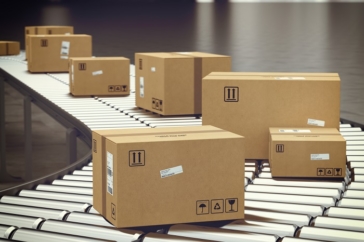-
ROSSLARE EUROPORT TARGETS HEALTH & SAFETY WITH CAMERA TELEMATICS PARTNERSHIP - 2 days ago
-
Landmark Study Reveals Wearable Robotics Significantly Boost Safety and Efficiency in Industrial Environments - July 24, 2024
-
Visku Tackle The Retail Seasonality Challenge One Pallet At A Time - July 22, 2024
-
KAMMAC AND BERGEN LOGISTICS STRENGTHEN FASHION & LIFESTYLE SERVICES IN THE UK - July 19, 2024
-
TENTBOX EXTENDS PARTNERSHIP WITH ARROWXL TO SUPPORT INCREASING DEMAND - July 17, 2024
-
The Perfume Shop improves customer journeys while driving profitability in partnership with Scurri - July 17, 2024
-
ZEROMISSION SECURES £2.3M ($3M) INVESTMENT TO ACCELERATE ELECTRIC FLEETS - July 16, 2024
-
BCMPA CELEBRATES SUCCESS OF 2024 CONFERENCE - July 15, 2024
-
Best of the Best: Jungheinrich Celebrates Triple International Award Win - July 12, 2024
-
GOPLASTICPALLETS.COM CALLS ON NEW CHANCELLOR RACHEL REEVES TO CONSIDER PLASTIC PACKAGING TAX REFORM - July 10, 2024
Dominic Potter, General Manager, International, Logistyx Technologies
The acceleration of ecommerce over the last couple of years has created huge opportunities for retailers to grow their online customer base and revenues. But the other side of this dramatic expansion is the pressure it’s placing on supply chains and ecommerce shipping and distribution operations. As e-commerce order volumes increase, available carrier capacity tightens. Add labour and driver shortages in fulfilment and logistics to the equation, and retailers’ ability to fulfil and deliver orders on time becomes severely compromised.
With no end in sight to the surge in parcel shipments, carrier capacity management is now top of mind for most retailers.
Why carrier capacity management is important
Every carrier has a maximum capacity for the volume of parcels it can ship over a period of time, which is tied to its existing infrastructure and resources. Based on inventory and order volume forecasts, retailers will negotiate with a carrier and commit to using a specific portion of the carrier’s available capacity to ship their products. If they fail to ship the contracted volume, they stand to lose money. If they overshoot the agreed capacity threshold, they’ll have to pay higher delivery rates for the additional shipments or face shipment delays. In the worst case, the carrier could refuse to ship the additional parcels.
In this climate, and with shipping volumes peaking, it’s no surprise many carriers have been running close to capacity. While some carriers will try to increase their capacity by acquiring more planes, trucks, and other delivery transport vehicles, most cannot take such drastic measures to increase their capacity and meet rising demand. The upshot is that carriers are levying high charges on customers that exceed their agreed capacity threshold. And in the current market, carriers are in a stronger position when renegotiating contracts.
At the same time, consumer desire for cheap and fast delivery of online orders is not going away. If anything, it is likely to increase. So, what are the options for retailers facing carrier capacity challenges?
Pooling shipping capacity through a network of carriers
Those that are tackling the problem well are balancing capacity across a pool of carrier partners. They have added business rules to their parcel shipping software to specifically address how to handle decisions related to capacity limitations, volume-related costs, and volume-related rate increases in order to automatically ensure they are maximising capacity utilisation and minimising transportation spend. Their software is configured to identify the best carrier for each delivery journey by analysing inventory locations, delivery timeframe, costs to ship, SLAs, and capacity thresholds with multiple carrier partners.
By providing a better understanding of the parcel volumes they can send through each contracted carrier at any time, the technology also lets them communicate accurate delivery times to better manage customers’ delivery expectations.
Reducing the demand for traditional carrier services
Increasingly, some retailers, e-commerce merchants, and other shippers are defining carrier capacity management in a broader way and including other tactics to help them ease the carrier capacity crunch. Typically, these tactics are focused on finding new ways to reduce their demand for traditional carrier services.
For example, a growing number of shippers are turning to the new breed of gig-economy couriers to handle the last mile of delivery and reduce the number of parcels shipped through more traditional carriers. During the early part of the pandemic, restaurants, cafes, supermarkets, and grocery stores embraced on-demand courier and messenger services to increase delivery capabilities and meet soaring order volumes. But now, other retail sectors are partnering with gig economy providers to deliver products directly from the store to the consumer, often within just a couple hours of order placement.
In the UK, Currys, the consumer electronics retailer, has partnered with Uber Eats to give Londoners the opportunity to arrange rapid delivery of chargers, printer cartridges, and other items in as little as 30 minutes, catering to the increasing number of people who are working from home. In the US, drugstore company Walgreens Boots Alliance is partnering with DoorDash, Uber, and others to offer same-day delivery – in as little as one hour. Motivated by the possibilities, more gig economy providers are working hard to rapidly implement the right technology to accommodate ecommerce delivery such as security, proof of delivery, signature capture, and more.
Using omnichannel and green choices to reduce delivery journeys
Retailers with omnichannel distribution capabilities have also begun re-examining their options for reducing reliance on traditional carriers. Not only are they increasing their use of ship-from-store to offset carrier capacity constraints, but many are also expanding their use of services like click-and-collect and curb-side pickup and offering incentives to encourage consumers to choose these fulfilment options. In the US, for example, Belk, Target, and Walmart were among the first to offer customers discounts for orders picked up in-store, and with carrier capacity constraints now making headlines, this idea is catching on with others.
In a similar way, retailers can reduce the number of delivery journeys they funnel through carriers by offering and incentivising customers to choose more environmentally friendly shipping. A good example is Amazon, which for years has given Prime members the option to reduce the number of individual deliveries to their homes by scheduling orders to arrive on a weekly delivery day. Other shippers are seeing the light, understanding that being environmentally friendly can align with meeting consumer demand and help to reduce their use of carrier capacity.
In today’s highly stretched parcel shipping landscape, with limited carrier capacity, rising shipping costs, and a carrier-led market, we can expect retailers to show increasing interest in finding new and creative ways to better manage their carrier capacity challenges.

































